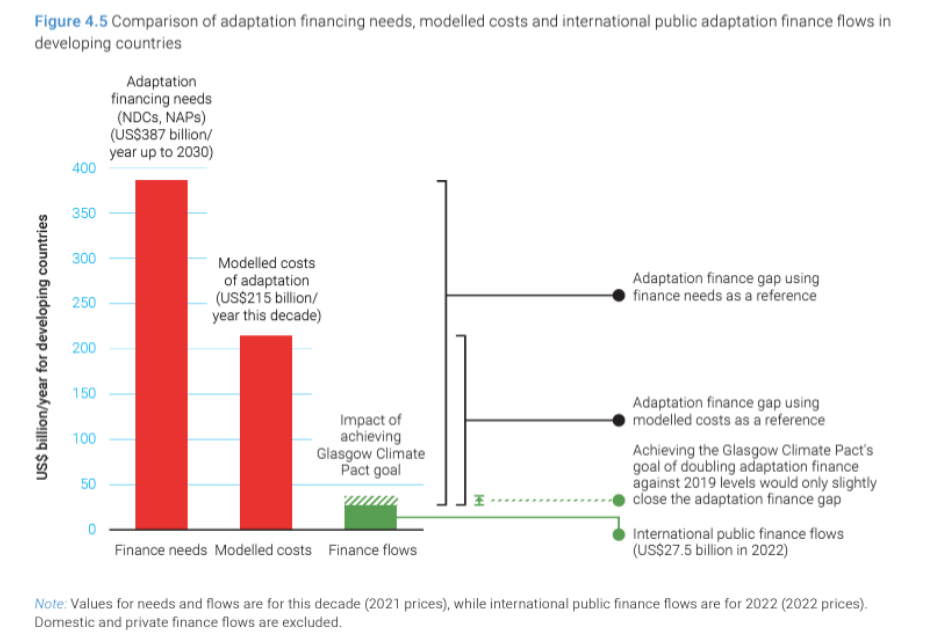Solving the Adaptation Finance Gap: Plans are in Place, but Funding Falls Short
The UN climate talks, COP29, is well underway, and countries have entered final negotiations on the New Collective Quantified Goal (NCQG), a new climate finance goal to boost funding for climate action in developing countries. Reaching agreement on the goal may be difficult in the face of the U.S election results, but it remains an urgent priority.
One glaring finance gap that we need to address in the new goal is finance for climate adaptation. Adaptation is how governments and communities prepare for and adjust to the impacts of climate change. It’s about making changes to reduce or prevent the harm caused by climate impacts like rising sea levels, more frequent storms, and hotter temperatures.
According to a new report from the United Nations Environment Programme (UNEP), adaptation needs are not being met worldwide. Developing countries will need $215 billion per year over the next decade for their adaptation priorities, from building climate resilient infrastructure to restoring ecosystems. Yet international finance flows for adaptation were just $28 billion in 2022 – an increase over prior years, but nowhere near enough.
Transformational adaptation requires closing the finance gap and maximizing the impact of every dollar.
Where is the world falling behind on adaptation?
Many developing countries are particularly vulnerable to climate change impacts, and the good news is that they are prioritizing efforts to build resilience. UNEP’s Adaptation Gap Report found that 87% of countries have at least one national adaptation planning instrument in place, compared to around just 50% a decade ago. These instruments include National Adaptation Plans (NAPs) and other strategies or policies that guide adaptation.
Now time for the bad news: although planning has improved, there is a growing gap in implementation as countries lack the necessary finance to meet their objectives. Adaptation has consistently been underfunded compared to mitigation, and while developed countries are working to double adaptation finance, the current $28 billion in annual flows represents just 13% of the $215 billion needed annually.
[Source: UNEP Adaptation Gap Report 2024]
The lack of finance for adaptation has serious implications for many developing countries, especially small island states which urgently need international support to strengthen resilience. For example, the Caribbean nation of Dominica is installing early warning systems to improve preparedness and reduce the impact of future hurricanes, but by 2023 they had only installed three systems and need 50 more to adequately cover the island. Without sufficient adaptation finance, the country will remain highly exposed to sudden climate shocks.
This finance gap is further complicated by limited private sector engagement in adaptation. UNEP finds that many transformational adaptation projects are seen as risky by private investors, due to their longer time frame for benefits and less clear return on investment. Private finance does flow to projects in infrastructure and commercial agriculture, but often not without efforts by the public sector to de-risk investments.
It is not surprising that two-thirds of adaptation financing needs are anticipated to be financed by the public sector. But the quality of public finance for adaptation has room for improvement as well. 62% of public finance for adaptation is delivered through loans, of which 25% are non-concessional, or at market rate with no favorable terms. And the use of non-concessional loans for adaptation in most vulnerable countries has actually increased in recent years. These tools have the potential to drive up the debt burden in developing nations which are already struggling to pay the bills. Expanding grant and concessional finance will be important to mitigate these challenges.
How do we unlock quality adaptation finance?
The Adaptation Gap Report suggests that filling the finance gap will require several enabling factors that can unlock new finance flows. Notably, in EDF’s new report ‘Quality Matters: Strengthening Climate Finance to Drive Climate Action,’ we identify similar strategies as we call for structural reforms within the international climate finance system. Three key recommendations overlap in both reports.
First, countries need to mainstream their climate objectives and adaptation goals within national planning and budgeting processes. This integration should be paired with robust stakeholder engagement that systematically includes subnational authorities, marginalized groups and potential implementing entities in the planning process. Doing so will better align adaptation activities with other national priorities and create more fundable projects. Moreover, planning processes should emphasize project evaluation and evidence gathering to better understand what interventions are most impactful and maximize the potential of climate resources.
Second, countries should adopt investment planning approaches to climate action. Specifically, they should work to develop a pipeline of bankable projects that can meet the objectives within their NAPs and other planning instruments. This can help attract investors to projects and ensure successful implementation of adaptation plans.
Third, multilateral financial institutions including multilateral development banks (MDBs) and climate funds need to undergo structural reform to improve the quality of finance. The MDBs are currently pursuing reforms to become better fit-for-purpose for addressing the climate crisis, and at COP29 they jointly announced that their collective climate finance will reach $120 billion by 2030 – though only $42 billion will be dedicated for adaptation. Improving the balance between mitigation and adaptation finance will be important to ensure that developing countries’ priorities don’t go unfunded. Additional actions these institutions can take include strengthening the concessionality of terms for adaptation projects to alleviate debt burdens and spark new blended finance opportunities, and leveraging innovative instruments like adaptation swaps which can foster positive adaptation outcomes in exchange for forgiving debt.
The NCQG is an important milestone which has the potential to advance action on these reforms and strengthen adaptation finance flows. Alongside supporting a strong quantitative goal, countries should call for improvements in the quality of finance, to ensure that finance for adaptation projects is available, accessible, concessional, and impactful.













